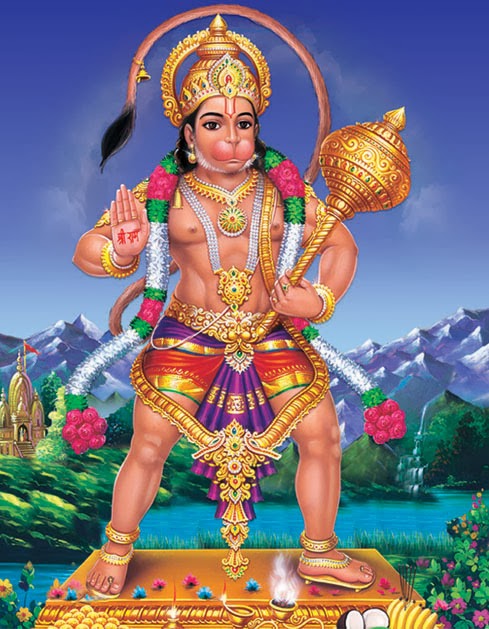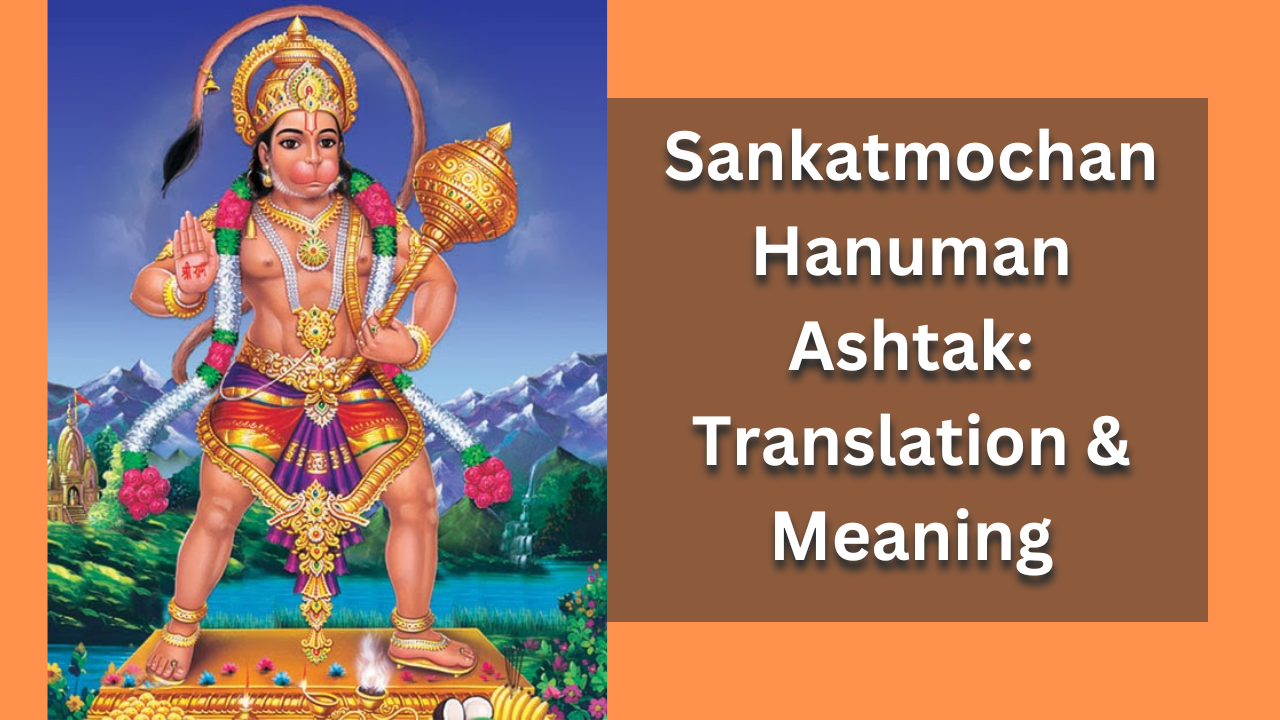I remember the first time I heard the Sankatmochan Hanuman Ashtak. I was a kid, sitting beside my grandmother as she softly recited it every evening. Back then, it felt like just another prayer, but as I grew older and started facing life’s challenges, the words began to resonate with me on a deeper level. The Sankatmochan Hanuman Ashtak isn’t just about devotion—it’s about finding strength, courage, and clarity when life feels overwhelming.
In this blog, I’ll walk you through the Sankatmochan Hanuman Ashtak translation and meaning. This isn’t tied to any particular religion or belief system—it’s about universal values like resilience, selflessness, and inner peace. Whether you’re spiritual or just looking for some life guidance, the Ashtak has something to offer.
Sankatmochan Hanuman Ashtak Translation & Meaning
॥ हनुमानाष्टक ॥
बाल समय रवि भक्षी लियो तब,
तीनहुं लोक भयो अंधियारों ।
ताहि सों त्रास भयो जग को,
यह संकट काहु सों जात न टारो ।
देवन आनि करी बिनती तब,
छाड़ी दियो रवि कष्ट निवारो ।
को नहीं जानत है जग में कपि,
संकटमोचन नाम तिहारो ॥ १ ॥
As a child, you swallowed the sun,
Plunging the three worlds into darkness.
The entire universe was terrified,
And no one could find a solution to this crisis.
The gods came and pleaded with you,
And you released the sun, ending the suffering.
Who in this world doesn’t know,
That you are called the remover of obstacles, O Hanuman?
Meaning:
This verse speaks of Hanuman’s immense power even as a child. Spiritually, it reminds us that we all possess untapped potential within, capable of influencing the world around us. It teaches us that challenges, no matter how big, can be overcome with inner strength. Hanuman’s willingness to release the sun after understanding its impact shows his compassion and wisdom. It symbolizes the importance of balancing power with responsibility and using our strengths for the greater good.
बालि की त्रास कपीस बसैं गिरि,
जात महाप्रभु पंथ निहारो ।
चौंकि महामुनि साप दियो तब,
चाहिए कौन बिचार बिचारो ।
कैद्विज रूप लिवाय महाप्रभु,
सो तुम दास के सोक निवारो ॥ २ ॥
When faced with Bali’s tyranny,
You, the Lord of Monkeys, carried a mountain without faltering.
Even when struck down, you rose again and again,
Keeping your heart focused on divine remembrance.
Meaning:
This verse highlights perseverance. No matter how many times life knocks us down, like Hanuman, we can rise again through faith and determination. It emphasizes resilience and unwavering focus during tough times.
अंगद के संग लेन गए सिय,
खोज कपीस यह बैन उचारो ।
जीवत ना बचिहौ हम सो जु,
बिना सुधि लाये इहाँ पगु धारो ।
हेरी थके तट सिन्धु सबै तब,
लाए सिया-सुधि प्राण उबारो ॥ ३ ॥
You went with Angad to search for Sita,
Resolving this great crisis.
You defeated Akshay Kumar,
And brought news of Sita, saving lives.
Meaning:
Hanuman’s mission to find Sita reflects loyalty and courage. It symbolizes the lengths we can go for those we care about and the importance of standing up against injustice.
रावण त्रास दई सिय को सब,
राक्षसी सों कही सोक निवारो ।
ताहि समय हनुमान महाप्रभु,
जाए महा रजनीचर मारो ।
चाहत सीय असोक सों आगि सु,
दै प्रभुमुद्रिका सोक निवारो ॥ ४ ॥
बान लग्यो उर लछिमन के तब,
प्राण तजे सुत रावन मारो ।
लै गृह बैद्य सुषेन समेत,
तबै गिरि द्रोण सु बीर उपारो ।
आनि सजीवन हाथ दई तब,
लछिमन के तुम प्रान उबारो ॥ ५ ॥
Ravana tormented Sita,
And struck Lakshman down with his weapon.
When Lakshman lay unconscious,
Your remembrance removed the crisis.
When an arrow struck Lakshman’s chest,
He lost consciousness as Ravana’s son attacked.
You brought the physician Sushena from his home,
And then, O brave one, you lifted the Dronagiri mountain.
Meaning:
Even in the gravest situations, Hanuman’s presence brought hope and healing. This teaches us that in times of despair, turning inward for strength and staying connected to our values can guide us through.
Lakshman, Lord Rama’s brother, was critically injured in battle by Indrajit, the son of Ravana. To save him, Hanuman flew to the Himalayas to fetch the Sanjeevani herb, known for its life-restoring properties. Unable to identify the exact herb, Hanuman lifted the entire Dronagiri mountain and brought it back, enabling Lakshman’s revival.
रावन युद्ध अजान कियो तब,
नाग कि फाँस सबै सिर डारो ।
श्रीरघुनाथ समेत सबै दल,
मोह भयो यह संकट भारो I
आनि खगेस तबै हनुमान जु,
बंधन काटि सुत्रास निवारो ॥ ६ ॥बंधु समेत जबै अहिरावन,
लै रघुनाथ पताल सिधारो ।
देबिहिं पूजि भलि विधि सों बलि,
देउ सबै मिलि मन्त्र विचारो ।
जाय सहाय भयो तब ही,
अहिरावन सैन्य समेत संहारो ॥ ७ ॥
During the war with Ravana, he used deceitful tactics,
And threw serpent nooses over everyone’s heads.
Lord Rama and his entire army were entrapped,
And this heavy crisis caused great confusion.
Then, Hanuman brought Garuda—the king of birds,
Who broke the serpent bonds and removed all fear.
Ahiravan, along with his brother,
Abducted Lord Rama to the netherworld—Patal.
They prepared to offer Rama in a sacrifice,
After worshipping the gods and consulting mantras.
You, Hanuman, rushed to help at that moment,
And destroyed Ahiravan and his entire army.
Meaning:
Ravana uses deceitful magic during the battle to bind Rama and his army with serpent nooses, leaving them helpless. Hanuman, in his wisdom, calls upon Garuda, the king of birds and natural enemy of serpents, to break the enchantments. Garuda’s presence frees everyone from the serpent bonds, symbolizing the breaking of illusions and fears that trap us in life.
Ahiravan, the ruler of the netherworld (Patal), abducted Rama and Lakshman to sacrifice them in a dark ritual. Hanuman, realizing the danger, descends into Patal, outsmarts Ahiravan, and ultimately destroys him along with his army, saving Rama and Lakshman.
काज किये बड़ देवन के तुम,
बीर महाप्रभु देखि बिचारो ।
कौन सो संकट मोर गरीब को,
जो तुमसे नहिं जात है टारो ।
बेगि हरो हनुमान महाप्रभु,
जो कछु संकट होय हमारो ॥ ८ ॥
You have accomplished great tasks for the gods,
O mighty and noble Lord, upon their request.
What trouble can afflict a humble person like me,
That you, Hanuman, cannot remove?
Quickly remove, O great Lord Hanuman,
Any difficulties or obstacles that I face.
Meaning:
This verse is a heartfelt plea from the devotee to Hanuman, recognizing his immense power and compassion. It reflects on how Hanuman has helped even the gods in their direst moments, emphasizing that if he can assist divine beings, he surely can help ordinary, humble people like us.
॥ दोहा ॥
लाल देह लाली लसे,
अरु धरि लाल लंगूर ।
वज्र देह दानव दलन,
जय जय जय कपि सूर ॥
The red body shines with redness,
And the red-colored langur (monkey) holds it.
The body, as hard as a thunderbolt, destroys the demons,
Victory, victory, victory to the heroic monkey (Hanuman).
Meaning:
This dohā describes the mighty Hanuman. His body is described as being vibrant and red, symbolizing energy, strength, and divinity. The red color could also symbolize his intense devotion to Lord Rama. The reference to the “red langur” is a symbolic connection to Hanuman, often depicted with reddish tones like the langur. The mention of a “thunderbolt-like body” refers to his indomitable strength and invincibility. The dohā ends with a call for victory to Hanuman, who is revered for his power, courage, and as the ultimate hero in destroying evil forces (represented by the demons). In essence, this dohā celebrates the immense strength, devotion, and heroic nature of Hanuman.
What to Learn form it?
Each verse of the Sankatmochan Hanuman Ashtak tells a story of courage, loyalty, and strength. When you break down the words, you realize it’s more than just praising Hanuman; it’s about finding your own inner hero.
1. Courage in the Face of the Impossible
Bal samay Ravi bhaksh liyo tab, Teenhū lok bhayo āndhiyāra.
Taahī sōtrāū Mahamuni jāke,
Kāhūkahī na lāgiyō pāra.
(In your childhood, you swallowed the sun, Plunging the three worlds into darkness.
Even great sages were left bewildered,
Unable to comprehend your power.)
This verse talks about Hanuman swallowing the sun as a child. Now, obviously, we’re not meant to take this literally. What it symbolizes is boundless courage—the idea that we’re capable of more than we think. How many times have we faced challenges that felt ‘too big’ to handle? The Ashtak reminds us that with the right mindset, nothing is insurmountable.
2. Loyalty and Selflessness
One of my favorite parts is when Hanuman helps Lord Rama find Sita. It’s not just about devotion to a deity—it’s about loyalty to a cause, to loved ones, and standing by what’s right. In our daily lives, this translates to being there for our friends and family when they need us the most.
3. Finding Strength in Adversity
The Ashtak repeatedly emphasizes overcoming obstacles (Sankat means crisis or obstacle, and Mochan means remover). It’s about realizing that hardships are a part of life, but they don’t define us. Instead, how we respond to them shapes who we are.

FAQs About Sankatmochan Hanuman Ashtak
1. What is the Sankatmochan Hanuman Ashtak?
The Sankatmochan Hanuman Ashtak is a devotional hymn dedicated to Lord Hanuman, known as the remover of obstacles (Sankatmochan). It consists of eight verses (Ashtak) that praise Hanuman’s strength, courage, and unwavering devotion.
2. Do I need to be religious to read the Sankatmochan Hanuman Ashtak?
Not at all. While it’s rooted in Hindu mythology, the Ashtak offers universal lessons about courage, resilience, and selflessness. It’s about tapping into your own inner strength, regardless of religious belief.
3. What are the benefits of reading the Sankatmochan Hanuman Ashtak?
Reading the Hanuman Ashtak can be incredibly calming. It helps reduce stress, build confidence, and cultivate a sense of inner peace. It’s like a mental reset when life feels overwhelming.
4. Can I read the Hanuman Ashtak in English?
Absolutely. While the original is in Awadhi (a dialect of Hindi), there are many translations available. The key is understanding the meaning behind the words and applying those lessons to your life.
5. When is the best time to read the Sankatmochan Hanuman Ashtak?
Traditionally, people read it on Tuesdays and Saturdays, days associated with Hanuman. But honestly, you can read it anytime you need a boost of courage or clarity.
Final Thoughts
The Sankatmochan Hanuman Ashtak isn’t just a hymn—it’s a guide to living a courageous and resilient life. It reminds us that no matter how big the challenge, we have the strength within us to overcome it. Whether you’re facing personal struggles, professional hurdles, or just the daily stresses of life, the Ashtak offers timeless wisdom that can help you navigate through it all.
If you’ve never read it before, give it a try. You don’t have to recite it perfectly or understand every word. Just let the essence of the verses sink in, and you might be surprised by the peace and strength you find.
Have you experienced the power of the Hanuman Ashtak? Share your thoughts and experiences in the comments below!

